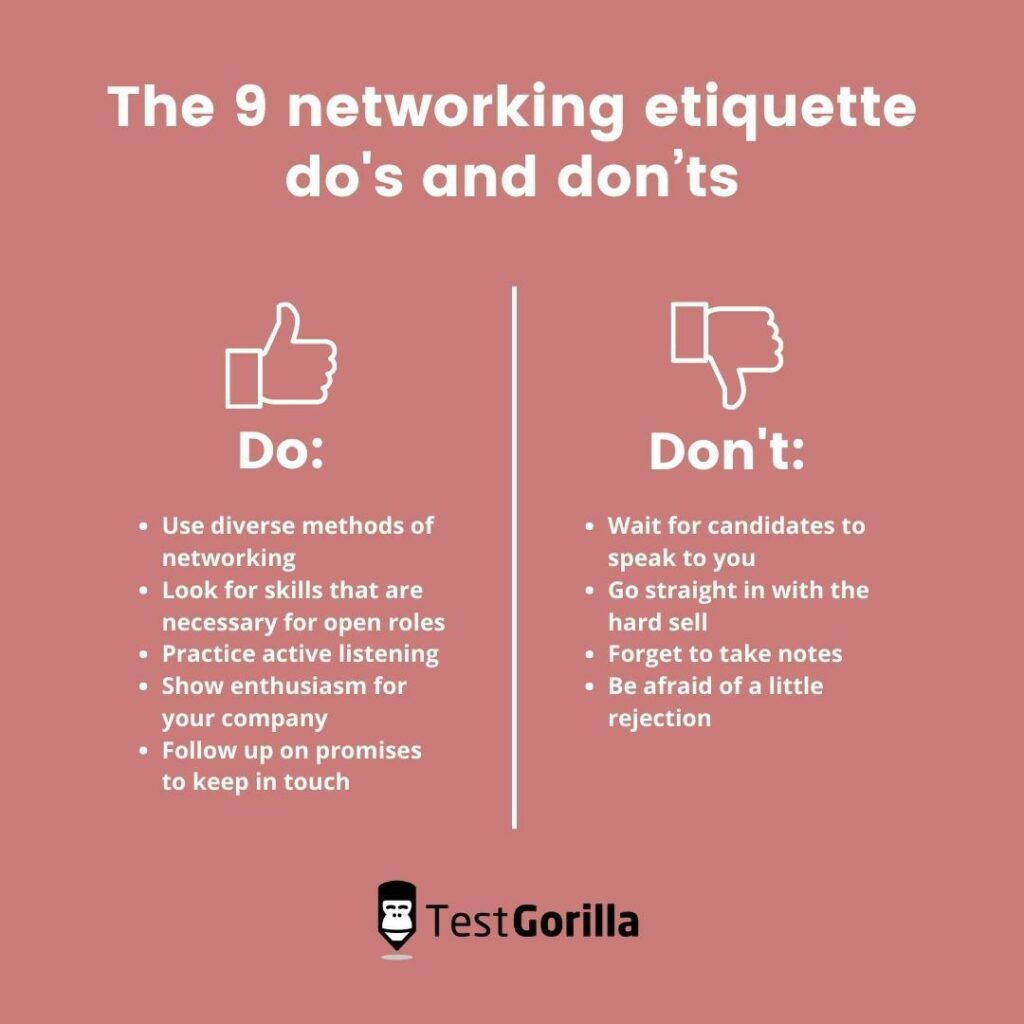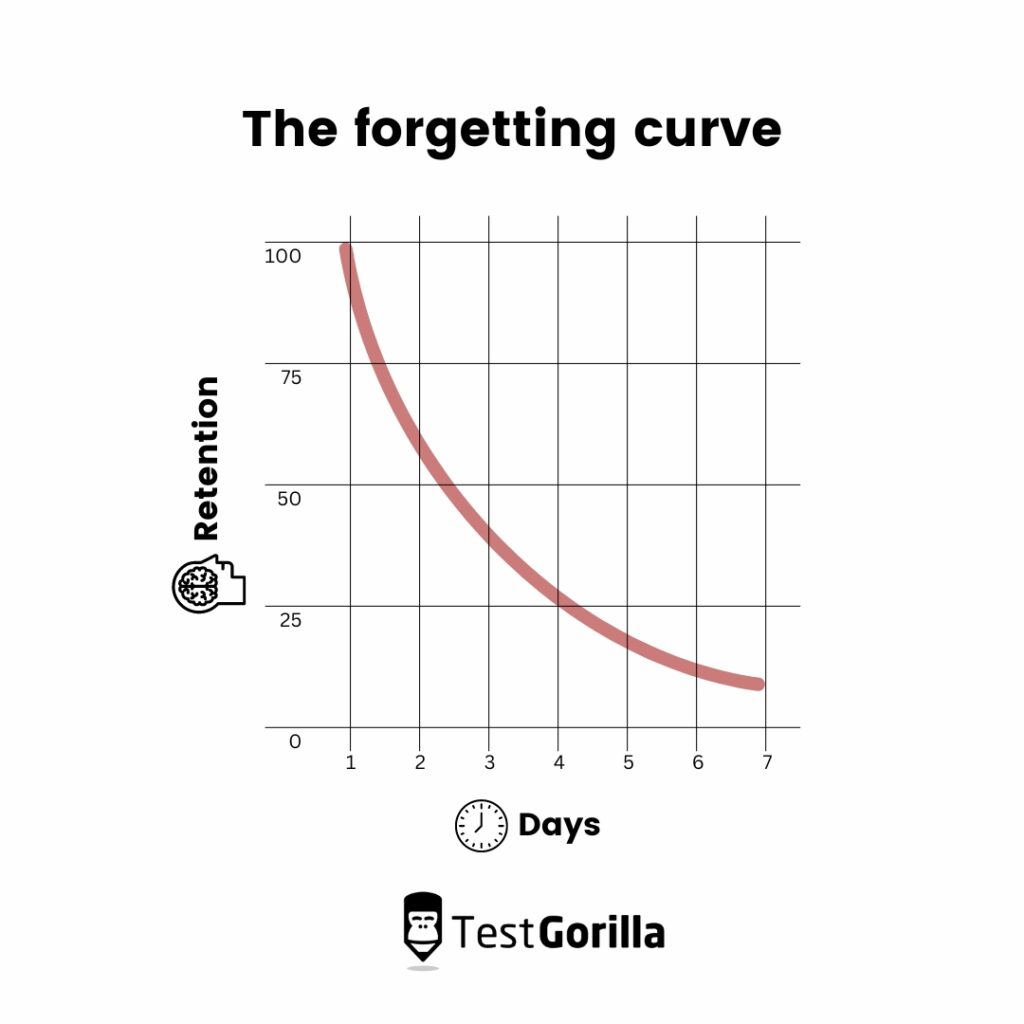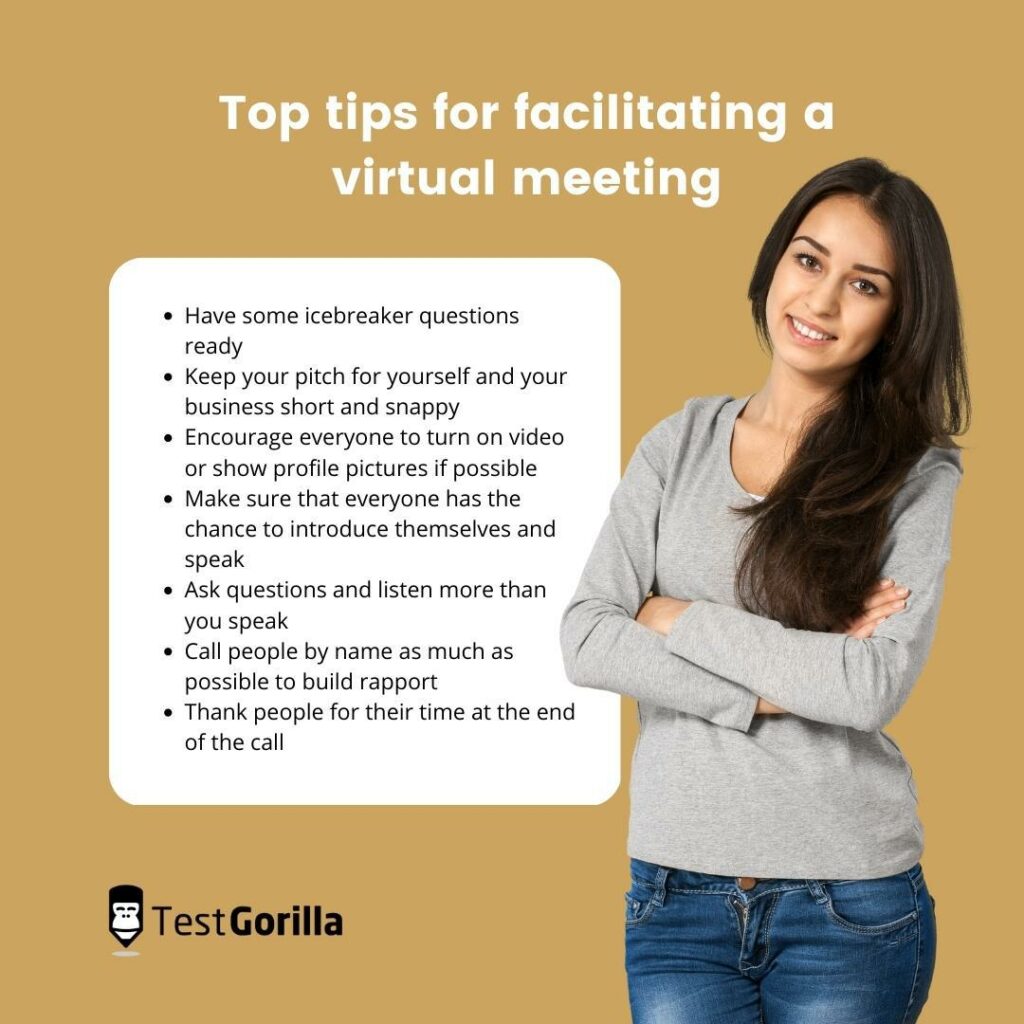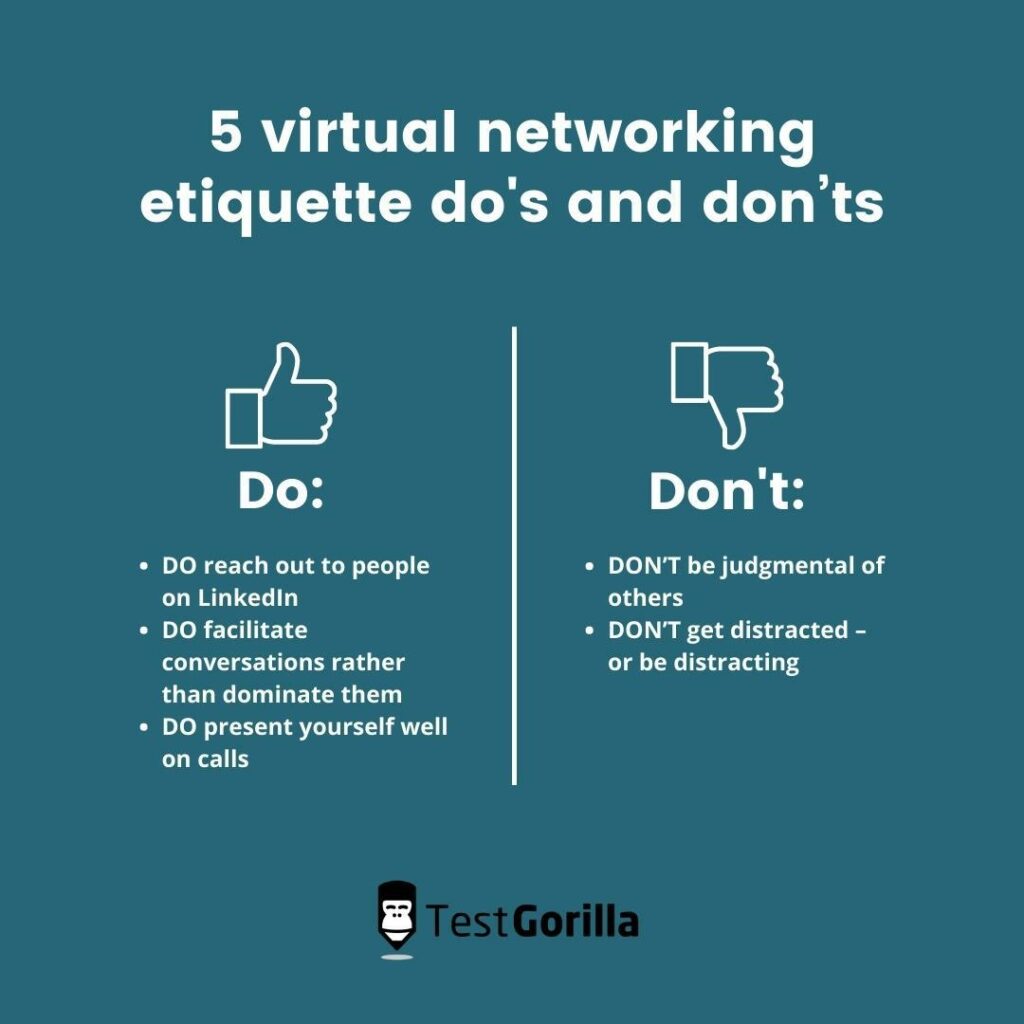Networking events get a bad rap, and we understand why.
From “HELLO! MY NAME IS _____” stickers to slices of pizza congealing on a buffet table, they don’t always scream “fun.”
But when one in four people find jobs through networking[1], you can’t afford to skip them.
Networking is a great way to find motivated recruits, even if they’re passive candidates who aren’t actively looking for new roles.
In this post, you’ll find the top dos and don’ts of networking etiquette for recruiters so that you can gather not just contacts but real connections to help grow your talent pool.
Table of contents
The importance of networking etiquette
Networking etiquette is important because it helps you establish and respect boundaries with potential candidates.
Unlike talking to colleagues, with whom you might have acquaintances, goals, and an employee code of conduct in common, strangers you meet at networking events haven’t given you implicit consent or encouragement, which can make it hard to know:
The appropriate level of formality
How much information to give about yourself
How to best present yourself to them
It’s a bit like dating: You need to put yourself (or rather, your company) out there in a way that doesn’t exert unfair pressure or make people uncomfortable.
So, what are the dos and don’ts of networking etiquette? We’re glad you asked…
The 9 networking etiquette dos and don’ts
Let’s start by talking about in-person networking opportunities. These come in many shapes and sizes and can include conferences, alumni events, and industry talks.
Here’s how – and how not – to act at a networking event.
9 networking etiquette dos and don’ts: summary table
In a rush? Perhaps you’re on your way to a networking event right now? Don’t worry; here’s the short version of our tips below.
In-person networking etiquette dos | In-person networking etiquette don’ts |
Use diverse methods like community-based networking and mentorship programs | Wait for candidates to start the conversation |
Look out for the skills you need for your open roles | Go straight in with the hard sell for your company or role |
Practice active listening, for example, repeating statements that have interested or impacted you | Forget to take note of important information like contact details and conversation points |
Show enthusiasm for your business and its culture | Be afraid of a little rejection |
Follow up on promises to stay in touch within 24 hours |
1. DO use diverse methods of networking
One of the best things you can do to broaden your network is to diversify your methods. A simple way to do this is to use your existing contacts to make referrals or introductions at events. At a trade show or expo, encourage colleagues to introduce you to people they know rather than going in cold.
Also, remember that you’re not just looking to reproduce the people you already have in your organization – you also want to create a diverse, balanced workforce.
Black professionals statistically prefer community-based networking, such as working with not-for-profits or engaging with mentorship programs. Minority communities are also often less likely to have in-built professional networks through family or school friends. Jeff Weiner, the chief executive officer of LinkedIn, calls this issue the “network gap.”
Thinking outside the box when it comes to how you meet people generates more connections and makes them more diverse.
2. DO look for skills that are necessary for open roles
It’s no secret that we think skills-based hiring is the way of the future. Skills testing can help you understand what someone can actually do, not just what degrees they have. Having key skills in mind while networking is also an excellent way to identify potential candidates.
Of course, no one’s going to reel off their skill set to you at a drinks mixer (unless the conversation has really hit a lull). But if you were looking for a social media manager, for example, you might look out for:
Opinions on how to use different platforms
Predictions about the future of different platforms
Anecdotes about successful campaigns
Thoughts and self-reflection on how they’ve responded to recent challenges
Maybe you already have an open role but no idea what skills are needed to fill that team. Before heading to your next networking event, conduct a skills gap analysis to see what skills you’re missing. It’s more than likely you have a skills gap – 87% of businesses either have one already or expect to in the next few years.
3. DO practice active listening
You’ve probably heard the statistic that 93% of communication is nonverbal.
If you’re neurodivergent, a little anxious, or maybe just feeling down on the day of a big mixer, this might stress you out. But don’t worry, this is actually a popular misunderstanding of two separate experiments conducted in the 1960s.
There’s no objective measure of how much it matters if you give “bad” non-verbal cues. After all, we’ve all had moments in which we were unsure what to do with our arms when walking. Showing our nerves through our body language is only human, and most people understand.
So, instead of fussing over specific behaviors to avoid, try showing your conversational partner that you are actively listening to what they are saying. You might:
Shake hands firmly and smile
Maintain eye contact when possible
Repeat phrases that resonate with you back to the speaker
Ask sincere questions about what they’ve said
Listen and watch for cues, for example, that they want to talk to someone else now
4. DO show enthusiasm for your company
It can be difficult to know how to describe your company culture. Most recruiters fall back on turning to their colleagues and saying, “We have fun, don’t we?”
Instead of doing this (which immediately tells candidates that you’re out of ideas), try:
Using simple but effective words that an individual might use to describe themselves – “driven,” “motivated,” and “collaborative” are all good examples
Telling a brief anecdote about a moment that you enjoyed from a recent social or meeting
Summing up the organization’s way of working in a short story about reaching a goal or milestone
Most importantly, be open and honest. There’s no point spinning a fairy tale about your workplace because many candidates might get suspicious and turned off if you go overboard with the hard sell.
5. DO follow up on promises to keep in touch – and quickly
As recruiters, it’s frustrating when great candidates ghost us. It’s not in our imagination, either – 28% of candidates admit to having done this.
But it’s time to put up our hands and admit we’re not perfect. The same survey showed that 77% of candidates have also been ghosted by a potential employer since March 2020.
Part of delivering a strong candidate experience is showing candidates respect and reliability from the beginning of their journey. Sticking to your word about following up with them gives them a good impression from the start.
Just as importantly, it ensures that they don’t forget about you. The “forgetting curve” is a model that describes how most people forget information after first absorbing it. Studies show that more than 50% of information is forgotten after just one day – so don’t get beaten by the curve.
6. DON’T wait for candidates to speak to you
You might be tempted to let candidates come to you if they’re interested in what your company does, and yes, being proactive is a green flag in a candidate.
However, you also don’t want to waste time playing hard to get when another business could snatch up top talent.
Be open and friendly when approaching people standing alone, and encourage group conversation with the people around you as much as possible. This might be by inviting candidates to talk to you and your colleagues or facilitating a conversation between strangers.
This approach benefits you and the candidate by helping you both expand your networks. Plus, everyone likes the person who rescues them from standing alone by the buffet table.
Here are some ideas for conversation openers you might use in different networking situations.
Type of event | Conversation starter |
Industry conference | I was just about to head over to the keynote speech, and I’d love some company. Want to join? And please tell me more about what you do. |
Recruitment fair | Hi, I’m [Name], and I work as [Role] for [Company]. I know quite a few of the other recruiters here. What sort of opportunities are you looking for? |
Professional lecture | That was a great lecture. I work for [Company], and we’ve been dealing with [topic] lately. I’m [Name]. What are you working on right now? |
7. DON’T go straight in with the hard sell
We can all agree that being aggressively “sold” to is one of the worst parts of networking events. One minute, you’re reaching for a slice of pizza, and the next, you’re hearing a total stranger talk about their tech startup.
Good news – you don’t have to be that stranger to get results.
Remember that you’re not there as a recruitment Cinderella; you don’t have to fill a role by midnight. You’re there to meet people, give a good first impression of your organization, and make new connections. Simply gather contact information, promise to be back in touch, and, as we said before, actually do it.
8. DON’T forget to take notes
Remember that forgetting curve we talked about? It applies to you, too. Remember to take notes on things like:
The names of the people you met
Their jobs and contact details
The roles they would be a good fit for
Any key information or conversation points you can reference when getting in touch
Don’t worry; we’re not telling you to carry a clipboard to your next conference. Here are some ways to take notes that aren’t intrusive.
During the networking event | After the networking event* |
Scan business cards into your phone using an app; Jot down brief notes on the back of candidates’ business cards between conversations | Make voice notes about each candidate on the ride home; Input all your new contacts into your CRM or your own system with notes; Add manual notes to contacts you scanned during the event |
*As a side note, if you do leave note-taking until after the event, we recommend that you:
Block out time for it in your schedule so that you don’t find yourself too busy to do it.
Do it as soon as possible after the event. Remember, the forgetting curve is steep.
9. DON’T be afraid of a little rejection
Remember that practice makes perfect.
We know it can be disheartening when someone is rude or dismissive at a professional networking event or you give your best and most considerate pitch and they still turn you down. But even the most charming networker doesn’t have a 100% hit rate with the people they talk to at networking events.
Instead of thinking of each conversation as an arrow that can hit or miss a specific target, think of yourself as casting a wide net and seeing what comes back.
5 virtual networking etiquette dos and don’ts
Once upon a time, networking almost always meant shaking hands with somebody in a conference center. But today, networking can just as easily happen on a conference call or social media.
Even though many of the above tips still apply – for example, looking out for key skills and taking notes of your conversations – there are also specific tips that apply to online networking etiquette.
5 virtual networking etiquette dos and don’ts: summary table
In the Zoom waiting room and want to refresh your online etiquette before the call starts?
We’ve got you.
Here is the abridged version of the dos and don’ts of online networking:
Virtual networking etiquette dos | Virtual networking etiquette don’ts |
Reach out to people on LinkedIn – bonus points for personalizing your message | Be judgmental of other people’s fidgeting or appearance |
Facilitate conversations in Zoom calls so that everyone benefits from the conversation and makes a positive association with you | Get distracted by your phone or look through other tabs in your browser – or have distracting elements on your end, such as unwanted noises |
Present yourself well on calls |
1. DO reach out to people on LinkedIn
Although it’s usually not appropriate to reach out to candidates on some platforms – nobody wants to open their Instagram DMs and see a pitch about a data analytics job – reaching out to potential candidates on LinkedIn is highly encouraged.
Engagement on the platform increased by 26% in 2022.
However, similar rules to the ones we described for in-person networking events apply. Avoid impersonal or pushy messages by doing the following:
Make sure you use their name in your message.
Reference a specific post or element of their profile that interests you.
State your intentions in your first message. Nobody likes to get a “Hey, how are you doing?” from a stranger.
2. DO facilitate conversations rather than dominate them
One of the best ways to make people remember you on a call is to take the lead by facilitating the conversation and not dominating it.
Facilitating virtual meetings so that they feel as natural as possible is a real skill. In a Zoom call or breakout room full of uncertain people, it improves everyone’s experience and creates positive associations with you and your company.
Here are our top tips for facilitating a virtual meeting:
Have some icebreaker questions ready.
Keep your pitch for yourself and your business short and snappy: “I’m [name]. I work for [company], helping [target customer] solve [problem] without the [negative alternative outcome].”
Encourage everyone to turn on video or show profile pictures if possible.
Make sure that everyone has the chance to introduce themselves and speak.
Ask questions and listen more than you speak.
Call people by name as much as possible to build rapport.
Thank people for their time at the end of the call.
3. DO present yourself well on calls
Though we might try not to think about appearances, more than half of remote workers admit to judging their colleagues’ office decor or furniture during virtual meetings.
Giving a good impression is part of any strong remote hiring process. In an ideal world, this would mean:
Dressing for the call so that you look professional
Removing unnecessary distractions from your background, whether by choosing an uncluttered location or using a Zoom background
Calling from a quiet location with a good microphone or headset so that participants can hear you clearly
However, we understand that this might not always be possible. A working camera and a stable internet connection aren’t always a given; not everyone has company or personal resources to invest in top-of-the-range equipment. Some ways you might combat these issues on video calls include:
Virtual networking issue | Potential solution |
Poor Wi-Fi connection or video quality | Turn off video and use a professional headshot instead so that the person can put a face to your voice. |
Calling from a noisy location | Mute your microphone when you’re not talking, and use headphones with an attached microphone to pick up your voice. |
Limited space or a cluttered background | Use a virtual background to remove distractions. If you want to get fancy, try buying or making a green screen to eliminate any blurry outline between you and the background. |
We know the struggle, and that’s why our next point is so important.
4. DON’T be judgmental of others
We’ve all seen those listicles of things not to do when networking – we’ve already talked about some of them above. However, just because you know body language dos and don’ts doesn’t mean you have to hold candidates to the same rigid standard.
Many of the sorts of tics usually frowned upon in these listicles – for instance, fidgeting – don’t meaningfully impact your ability to hold a conversation. In some cases, they might be signs of neurodivergence, such as ADHD.
This comes back to what we were saying earlier about active listening. Feeling respected and listened to is the most important factor in a conversation, so the next time you’re judging someone for playing with their hair on a call, ask yourself if it’s actually affecting your conversation.
5. DON’T get distracted – or be distracting
You wouldn’t check a text in the middle of an in-person mixer or send emails while other people were making introductions at a conference, so it’s not okay to do these things on a Zoom call.
Make this job easier for yourself by anticipating and avoiding potential distractions. For instance, avoid joining virtual meetings from loud places like cafes where you can be easily interrupted.
Also avoid distracting other people with your backdrop. A bedroom can often feel too intimate; a bare wall or neutral office is best.
If you have to type during the meeting – for instance, to take notes – do it on the same screen so that the other people on the call don’t feel that you’re looking away from them, and always mute your microphone so that they can’t hear the keyboard.
Finally, if you have the resources and expect to do a lot of networking online, consider permanent technical solutions like a unidirectional microphone to eliminate background noise that could make it hard for people to pay attention to you.
Use good networking etiquette to engage promising candidates
Networking is one of the most effective ways to build a diverse and effective workforce. It also enables you to understand what’s going on in your industry and what you should look for in your hires.
In this post, we’ve shown you how to approach people and make real connections, whether you’re doing it through a screen or face to face.
You’ve now got the know-how to reel in great candidates. Why not check out our Culture Add test to find out if they can positively contribute to your organization?
If you’re looking to expand your recruitment efforts, read up on recruitment email marketing.
Sources
Delgado, Michelle. (January 9, 2019). “How Do People Find Jobs?”. Clutch. Retrieved November 5, 2022. https://clutch.co/hr/recruiting/resources/how-people-find-jobs
Related posts
Hire the best candidates with TestGorilla
Create pre-employment assessments in minutes to screen candidates, save time, and hire the best talent.
Latest posts
The best advice in pre-employment testing, in your inbox.
No spam. Unsubscribe at any time.

Hire the best. No bias. No stress.
Our screening tests identify the best candidates and make your hiring decisions faster, easier, and bias-free.
Free resources
This checklist covers key features you should look for when choosing a skills testing platform
This resource will help you develop an onboarding checklist for new hires.
How to assess your candidates' attention to detail.
Learn how to get human resources certified through HRCI or SHRM.
Learn how you can improve the level of talent at your company.
Learn how CapitalT reduced hiring bias with online skills assessments.
Learn how to make the resume process more efficient and more effective.
Improve your hiring strategy with these 7 critical recruitment metrics.
Learn how Sukhi decreased time spent reviewing resumes by 83%!
Hire more efficiently with these hacks that 99% of recruiters aren't using.
Make a business case for diversity and inclusion initiatives with this data.























